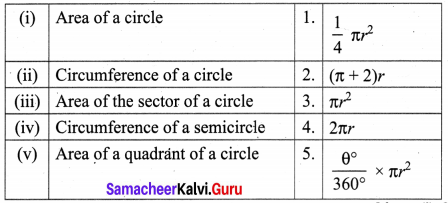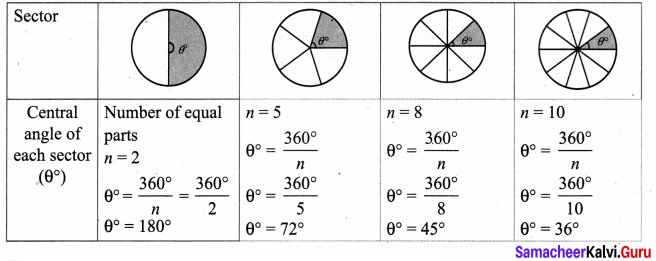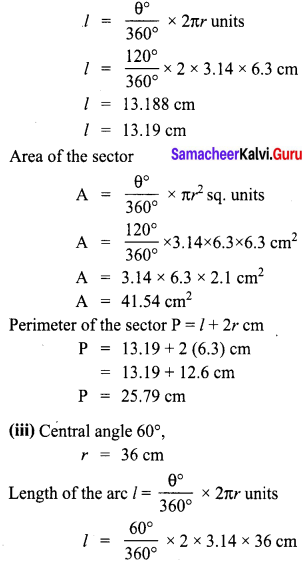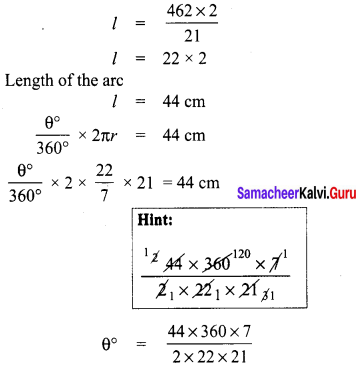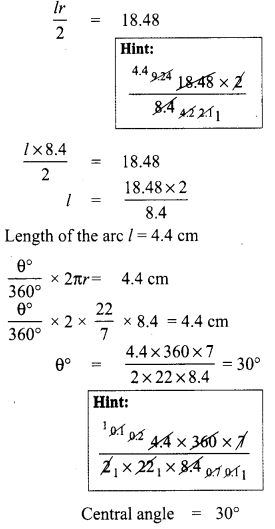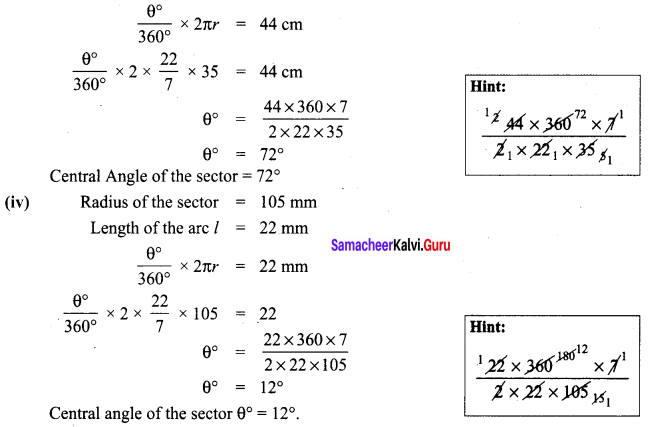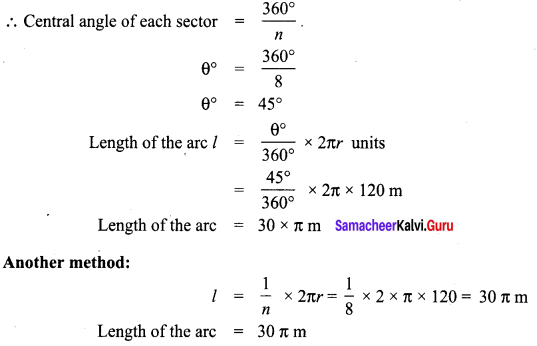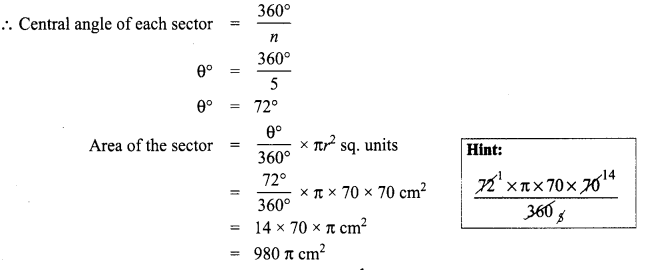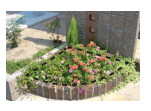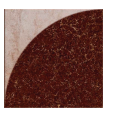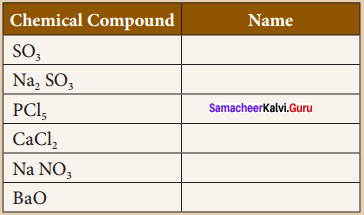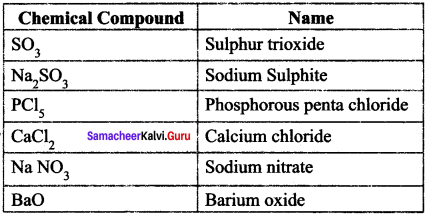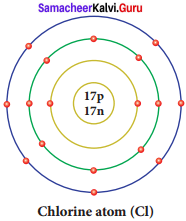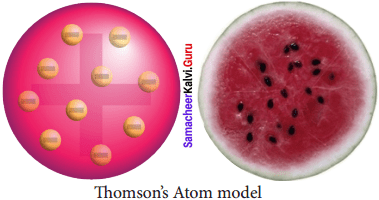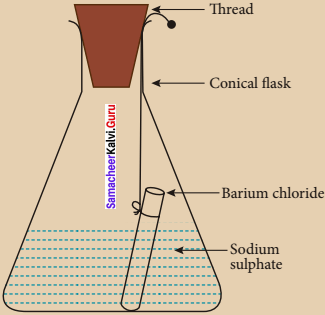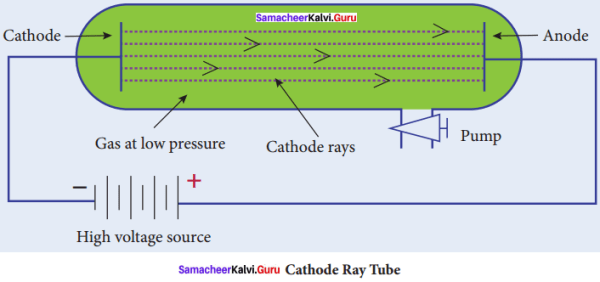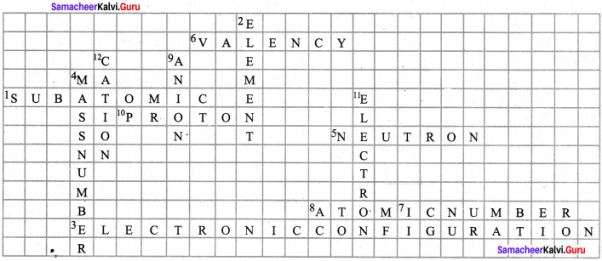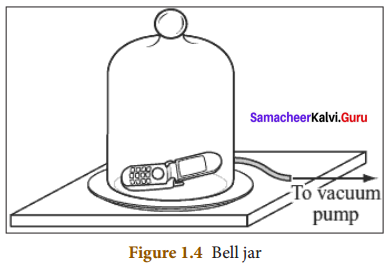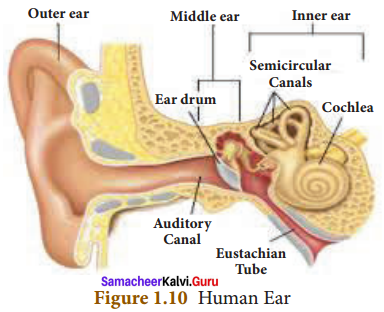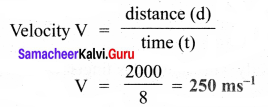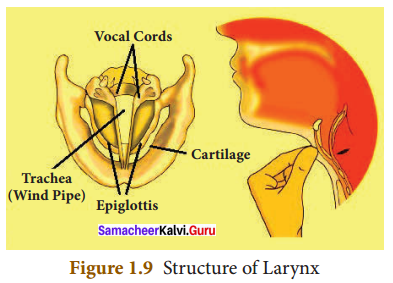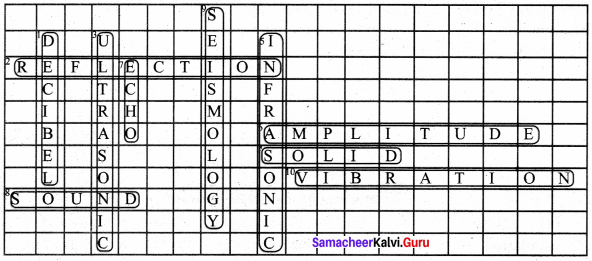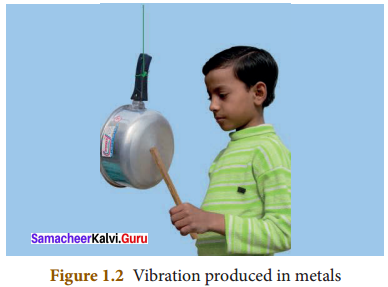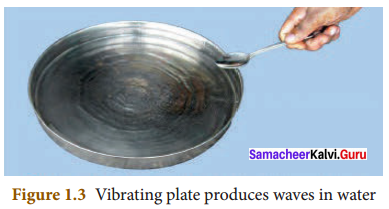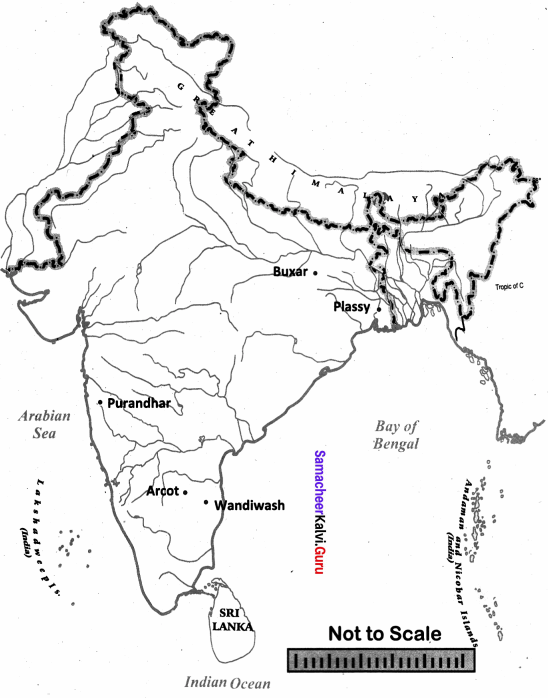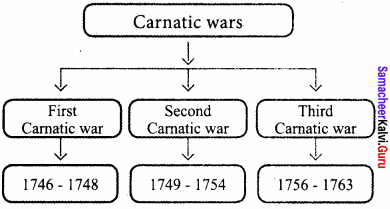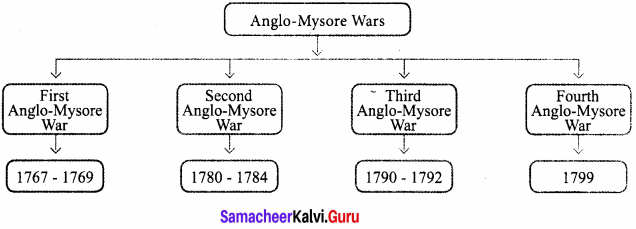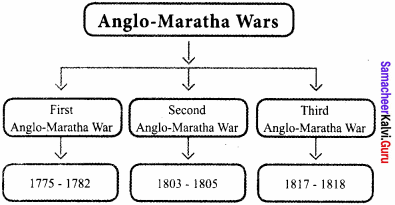Students can Download Science Term 3 Chapter 4 Water Questions and Answers, Notes Pdf, Samacheer Kalvi 8th Science Book Solutions Guide Pdf helps you to revise the complete Tamilnadu State Board New Syllabus and score more marks in your examinations.
Tamilnadu Samacheer Kalvi 8th Science Solutions Term 3 Chapter 4 Water
Samacheer Kalvi 8th Science Water Text Book Exercise
I. Choose the best answer:
8th Standard Science Water Lesson Question 1.
Water changes to ice at ………….
(a) 0°C
(b) 100°C
(c) 102°C
(d) 98°C
Answer:
(a) 0°C
8th Standard Science Water Lesson Notes Question 2.
Solubility of carbon dioxide in water is high when the ………….
(a) pressure is low
(b) pressure is high
(c) temperature is high
(d) None of the above
Answer:
(b) pressure is high
8th Standard Water Lesson Question 3.
The gas collected at the cathode on electrolysis of water is ………….
(a) oxygen
(b) hydrogen
(c) nitrogen
(d) carbon dioxide
Answer:
(b) hydrogen
Samacheer Kalvi Guru 8th Science Question 4.
Which of the following is a water pollutant?
(a) Lead
(b) Alum
(c) Oxygen
(d) Chlorine
Answer:
(a) Lead
Samacheer Kalvi Guru 8th Question 5.
Permanent hardness of water is due to the presence of ………….
(a) Sulphates and Chlorides
(b) Dust particles
(c) Carbonates and Bicarbonates
(d) Other soluble particles
Answer:
(a) Sulphates and Chlorides
II. Fill in the blanks:
- Water is colourless, odourless and ………….
- The boiling point of water is ………….
- Temporary hardness of water can be removed by …………. of water
- The density of water is maximum at …………..
- Loading speeds up the process of …………..
Answer:
- tasteless
- 100°C
- boiling
- 4°C
- Sedimentation
III. State True or False. If false, correct the statement:
Samacheer Kalvi 8th Science Solutions Question 1.
Sewage should be treated well before being discharged it into water bodies.
Answer:
True.
Samacheer Kalvi 8th Science Book Solutions Question 2.
Sea water is suitable for irrigation as it contains dissolved salts.
Answer:
False.
Correct statement:
Sea water is not suitable for irrigation as it has high salinity.
Samacheer Kalvi Science 8th Standard Question 3.
Excessive use of chemical fertilizers depletes the soil and causes water pollution.
Answer:
True.
Samacheer Kalvi.Guru 8th Question 4.
Water unfit for drinking is called potable water.
Answer:
False
Correct statement:
Water suitable for drinking is called potable water.
Samacheer Kalvi 8th Standard Science Question 5.
Soap lathers well in hard water.
Answer:
False
Correct statement:
Soap lathers well in soft water.
IV. Match the following:
- Universal solvent – Water Pollutant
- Hard water – Kills germs
- Boiling – Ozonisation
- Sterilization – Water
- Sewage – Stomach ailments
Answer:
- Universal solvent
- Hard water
- Boiling
- Sterilization
- Sewage
V. Give reasons for the following:
Samacheer Kalvi Science 8th Question 1.
Alum is added to water in sedimentation tank.
Reason:
- Chemical substance potash alum is added to water to speed up the process of sedimentation.
- This process is called loading.
- The particles of potash alum combine with the suspended impurities and make them settle down at a faster rate.
Samacheer Kalvi Guru 8th Science Solutions Question 2.
Water is a universal solvent.
Reason:
- Water has a unique property to dissolve more substances than any other liquids.
- It can dissolve solids such as salt and sugar, liquids such as honey and milk and gases such as oxygen and carbon dioxide in it.
- Water can dissolve more number of substances than any other solvent.
- Therefore, it is called as universal solvent.
Samacheer Kalvi 8th Science Guide Question 3.
Ice floats on water.
Reason:
- This is because ice is lighter than water.
- It means that the density of ice is lower than that of water.
- Since ice is a bad conductor of heat it does not allow heat to pass through it.
- So, the water below the ice remains in liquid form, where most of the aquatic life lives.
Samacheer Kalvi 8th Books Science Question 4.
Aquatic animals can breathe in water.
Reason:
- Air dissolved in water is important for the aquatic animals to survive.
- Aquatic animals extracts the oxygen form the water and expels water.
- They can breathe in water only through the dissolved oxygen present in water.
Samacheer Kalvi 8th Science Question 5.
Sea water is unfit for drinking.
Reason:
- Every litre of sea water contains 35 grams of dissolved salts most commonly known as sodium chloride (NaCl).
- Such water is called saline water.
- It is not suitable for drinking and is said to be non-potable water.
Samacheer Kalvi 8th Science Book Question 6.
Hard water is not good for washing utensils.
Reason:
Hard water damages the utensils and containers in which it is stored and forms a hard layer.
VI. Define the following:
Samacheer Kalvi 8th Books Solutions Science Question 1.
Freezing Point.
Answer:
The temperature at which a liquid turns into solid when cooled is known as freezing point. The freezing point of water is 0°C.
8th Standard Samacheer Kalvi Science Question 2.
Boiling point.
Answer:
The temperature at which a water boils and changes to steam is called as boiling point. The boiling point of water is 100°C at atmospheric pressure.
Samacheer Kalvi Guru 8th Standard Question 3.
Specific heat capacity.
Answer:
Amount of heat that is needed to raise the temperature of a unit mass of a substance by 1°C is called specific heat capacity.
8th Standard Science Samacheer Kalvi Question 4.
Latent heat of fusion.
Answer:
The amount of heat energy required by ice to change into water is called latent heat of fusion of ice.
Samacheer Kalvi 8 Science Book Question 5.
Potable water.
Answer:
The water suitable for drinking is called potable water.
VII. Answer in brief:
Question 1.
Name the gas evolved at cathode and anode when water is electrolysis. State their ratio by volume.
Answer:
- The gas which is evolved at cathode: Hydrogen (H2).
- The gas which is evolved at anode: Oxygen (O2)
- The ratio of H2 and O2 = 2 : 1.
Question 2.
State the importance of dissolved oxygen and carbon dioxide in water.
Answer:
- Fish extracts the oxygen from the water and expels water through the gills. Fish can survive in water only through the dissolved oxygen present in water.
- Aquatic plants make use of dissolved carbon dioxide for photosynthesis.
- Carbon dioxide dissolved in water reacts with limestone to form calcium bicarbonate.
- Marine organisms such as snails, oysters, etc., extract calcium carbonate from calcium bicarbonate to build their shells.
Question 3.
What are the causes of temporary hardness and permanent hardness of water?
Answer:
- Temporary hardness is due to the presence of carbonate and bicarbonate salts of calcium and magnesium.
- Permanent hardness is due to the presence of chloride and sulphate salts of calcium and magnesium.
Question 4.
Define specific latent heat of vaporization of water.
Answer:
- When water attains the temperature of 100°C, it starts changing its state from liquid to gaseous state, however, the temperature of water does not rise above 100°C.
- It is because the heat energy supplied only changes the state of the boiling water.
- This heat energy is stored in steam and is commonly called latent heat of vaporization of steam.
Question 5.
What are the methods of removing hardness of water?
Answer:
- Boiling – Temporary hardness is easily removed from water by boiling.
- Adding washing soda – Washing soda is used to remove permanent hardness of water.
- Ion-exchange – This converts hard water into soft water.
- Distillation – Temporary and permanent hardness both can be removed by the method of distillation.
VIII. Answer in detail:
Question 1.
How is water purified at a water purification plant?
Answer:
In conventional water treatment plant, water is subjected to different process. They are:
Sedimentation:
- Water from lakes or rivers is collected in large sedimentation tanks.
- There, it is allowed to stand undisturbed so that suspended impurities settle down at the bottom of the tank.
- Sometimes, a chemical substance such as potash alum is added to water to speed up the process of sedimentation, this is called loading.
- The particles of potash alum combine with the suspended impurities and make them settle down at a faster rate.
Filtration:
- Water from the sedimentation tanks is then pumped to the filtration tanks.
- Filtration tanks contain filter beds made up of gravel, sand, pebbles, activated charcoal and concrete.
- Water passes through these layers and becomes free from any remaining dissolved or suspended impurities completely.

sterilisation:
- The filtered water is treated chemically to remove the remaining germs or bacteria, this process is called sterilisation.
- The chemicals that are used in this process are chlorine and ozone.
- The process of adding chlorine in adequate amounts to water is called chlorination.
- The water from filtration tanks is pumped into chlorination tanks, where chlorine is added to remove harmful bacteria and other germs.
- Ozonisation is a process in which water is treated with ozone gas to kill the germs present in it.
- The sterilisation of water can also be done by exposing it to air and sunlight.
- Oxygen from the air and sunlight destroy the germs present in water.
- Aeration is the process in which air under pressure is blown into filtered water, this also helps to kill the germs.
Question 2.
What is permanent hardness of water? How can it be removed?
Answer:
The hardness due to the presence of chloride and sulphate salts of calcium and magnesium is known as permanent hardness of water.
Removal of hardness:
1. Adding washing soda.
- Washing soda is used to remove permanent hardness of water.
- It converts chlorides and sulphates into insoluble carbonates.
- These insoluble carbonates are removed by filtration.
2. Distillation.
- Temporary and permanent hardness both can be removed by the method of distillation.
- The water obtained after distillation is called distilled water.
- It is the purest form of water.
Question 3.
What is Electrolysis? Explain the electrolysis of water.
Answer:
The process of breaking down of water molecules by the passage of electric current is known as electrolysis of water.
Electrolysis of Water:
- A glass beaker is fixed with two carbon electrodes and it is filled with water up to one third of its volume.
- The positive carbon electrode acts as anode and the negative carbon electrode acts as cathode.
- Two test tubes are placed on the electrodes.
- The electrodes are connected to a battery’ and current is passed until the test tubes are filled with a particular gas.
- If the gas collected is tested using a burning splint we can notice that the gas in cathode side bums with a popping sound when the burning splint is brought near the mouth of the test tube.
- This property is usually shown by hydrogen gas and so it is confirmed that the gas inside the test tube is hydrogen.
- The burning splint placed near the anode side bums more brightly confirming that it is oxygen gas. This experiment shows that water is made up of hydrogen and oxygen.
- The ratio of hydrogen and oxygen is 2:1. Hence, for every two volumes of hydrogen collected at the cathode, there is one volume of oxygen collected at the anode.
![]()
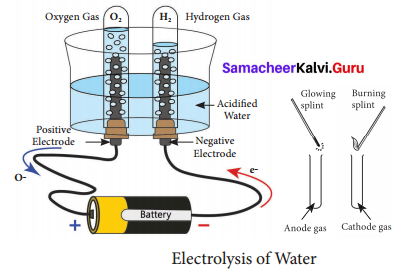
Question 4.
Explain the different ways by which water gets polluted.
Answer:
1. Domestic Sewage.
Untreated sewage contains impurities such as organic matter from food waste, toxic chemicals from household products and it may also contain disease-causing microbes.
2. Domestic waste and plastics.
Plastics block drains spreading vector borne diseases such as malaria and dengue. Waste in water bodies negatively impact aquatic life.
3. Agricultural activities
- Fertilizers, pesticides and insecticides used in agriculture can dissolve in rainwater and flow into water bodies such as rivers and lakes.
- This causes an excess of nutrients such as nitrates and phosphates as well as toxic chemicals into the water bodies and they can be harmful to aquatic life.
4. Industrial waste.
- Many industries release toxic waste such as lead, mercury, cyanides, cadmium, etc.
- If this waste is unregulated and is released into water bodies, it negatively impacts humans, plants, animals and aquatic life.
5. Oil spills.
Oil spills cause water pollution which is harmful to aquatic life.
6. Thermal pollution.
Water used for cooling purposes is discharged back to a river or to original water source at a raised temperature and sometimes with chemicals. This rise in temperature decreases the amount of oxygen dissolved in water which adversely affects the aquatic life.
Samacheer Kalvi 8th Science Water Additional Questions
I. Choose the correct Answer:
Question 1.
What is the chemical formula of water?
(a) HO2
(b) H2O
(C) H2O2
(d) HO
Answer:
(b) H2O
Question 2.
In which one of the following states water is present on Earth?
(a) solid
(b) liquid
(c) gas
(d) All of these
Answer:
(d) All of these
Question 3.
In the process of electrolysis of water, the positive carbon electrode acts as ……………..
(a) cathode
(b) anode
(c) both a and b
(d) none
Answer:
(b) anode
Question 4.
The boiling point of water increases with …………….. in pressure.
(a) decrease
(b) increase
(c) increase or decrease
(d) none
Answer:
(b) increase
Question 5.
The freezing point of water …………….. with increase in pressure.
(a) increase
(b) decreases
(c) remains same
(d) none
Answer:
(b) decreases
Question 6.
Every litre of sea water contains …………….. grams of dissolved salts.
(a) 40
(b) 70
(c) 35
(d) 10
Answer:
(c)35
Question 7.
The process of adding chlorine in adequate amounts to water is called ……………..
(a) Sterilisation
(b) Ozonisation
(c) Aeration
(d) Chlorination
Answer:
(d) Chlorination
Question 8.
…………….. from the air and sunlight destroy the germs present in water.
(a) Oxygen
(b) Hydrogen
(c) Nitrogen
(d) none
Answer:
(a) Oxygen
Question 9.
Aquatic plants make use of dissolved …………….. for photosynthesis.
(a) O2
(b) CO2
(c) N2
(d) H2
Answer:
(b)CO2
Question 10.
Which one of the following has the highest latent heat of vaporization?
(a) Ice
(b) Water
(c) Steam
(d) Metal
Answer:
(c) Steam
II. Fill in the blanks:
- The chemical name of water is …………….
 …………….
…………….- Water was first prepared by ……………..
- Pure water boils at ……………. °C at one atmospheric pressure.
- Freezing of water will cause an ……………. is the volume.
- ……………. has the highest latent heat of fusion.
- One gram of water requires ……………. of heat to raise its temperature by l°C.
- Water is circulated around car engine using the ……………. pump and the heat is absorbed.
- Pure water is ……………. and it shows no action towards litmus paper
- ……………. does not react with water and any temperature.
Answer:
- Dihydrogen monoxide
- O2
- Henry Cavendish
- 100
- expansion
- Ice
- 1 Calorie
- radiator
- neutral
- Copper
III. True or False. If false, give the correct statement:
Question 1.
Washing soda is used to remove permanent hardness of water.
Answer:
True.
Question 2.
Temporary and permanent hardness both can be removed by the method of boiling.
Answer:
False
Correct statement:
Temporary and permanent hardness both can be removed by the method of distillation.
Question 3.
The pleasant taste of drinking water is due to the presence of dissolved substance which include air, CO2 and minerals.
Answer:
True.
Question 4.
Micro-plastics can be found in almost every freshwater source.
Answer:
True.
Question 5.
During electrolysis, hydrogen and oxygen are obtained in the ratio 1 : 2.
Answer:
False
Correct statement:
During electrolysis, hydrogen and oxygen are obtained in the ratio 2:1.
IV. Match the following:
- Density of pure water – (a) Inflammable air
- Henry Cavendish – (b) Cathode
- Hydrogen – (c) 1 g/cm3
- Negative carbon electrode – (d) Hydrogen
Answer:
- c
- d
- a
- b
V. Very short answer questions:
Question 1.
Name the process by which temporary hardness is easily removed from water.
Answer:
Boiling.
Question 2.
Name the chemical which converts chlorides and sulphates into insoluble carbonates.
Answer:
Washing soda.
Question 3.
What is the taste of distilled water & boiled water?
Answer:
No taste.
Question 4.
When did Henry Cavendish discover Water?
Answer:
Water was first prepared in 1781 by an English scientist Henry Cavendish.
VI. Short Answer Questions:
Question 1.
What are the sources of water pollution?
Answer:
- House hold detergents
- Domestic sewage
- Domestic waste and plastics
- Agricultural activities
- Oil spills
- Industrial waste.
Question 2.
How plastic sheets affect the soil?
Answer:
- Plastic sheets are used in agriculture to grow vegetables.
- At the end of the season, these plastic sheets are ploughed back into the soil.
- The plastic sheets break into tiny pieces and get eaten by earthworms, which is harmful to their health and that of soil.
Question 3.
Write a note on ion-exchange.
Answer:
- Another method used to remove the hardness of water is to pass it through a column of ion-exchange resins where calcium and magnesium ions get replaced by sodium ions.
- This converts hard water into soft water.
Question 4.
What is the reason for hardness of water?
Answer:
The hardness of water is due to the presence of dissolved salts of calcium and magnesium.
Question 5.
Mention the disadvantages of hard water.
Answer:
- It is not good for washing clothes. It forms scum with soap and detergents, which makes the soap ineffective and also spoils the clothes further.
- It damages the utensils and containers in which it is stored and forms a hard layer.
- It forms scales on the machine parts used in industries and decreases their efficiency.
- It results in stomach ailments if consumed for a long period.
Question 6.
What is soft water?
Answer:
Water contains a number of dissolved salts and minerals. When these salts are present in very small quantities in water, it is called soft water.
Question 7.
Write the characteristics of potable water.
Answer:
- Potable water should be colourless and odourless.
- II should be transparent.
- It should be free from harmful micro-organisms such as bacteria, virus and protozoa.
- It should be free from suspended impurities.
- I should contain some minerals and salts, necessary for our body and some dissolved gases to add taste.
Question 8.
Write a short note on catalytic nature of water.
Answer:
Water acts as a catalyst in a number of reactions. Perfectly dry hydrogen and chlorine gases do not react in the presence of sunlight. However in the presence of traces of water, the reaction takes place with explosion to produce hydrogen chloride.
![]()
Question 9.
What are the physical properties of pure water?
Answer:
Pure water is a clear and transparent liquid:
- Pure water boils at 100° C at one atmospheric pressure.
- Pure water freezes at exactly 0°C at one atmospheric pressure.
- Pure water has a density of 1 gm/cm3.
Question 10.
Write the chemical equation for the production of water when zinc reacts with sulphuric acid.
Answer:
Zn + H2SO4 → ZnSO4 + H2
2H2+ O2 → 2H2O
VII. Answer in detail:
Question 1.
Tabulate the sources and effects of domestic and industrial pollutants.
Answer:

Question 2.
Mention some simple ideas to avoid water pollution.
Answer:
- Use detergents that are biodegradable and avoid those that contain toxic chemicals,
- Wear clothing that is made from natural fibres such as cotton and avoid wearing synthetic fibres such as nylon.
- Do not throw waste such as plastics into water bodies. Always separate your waste into recyclable, non-recyclable and biodegradable so that it does not cause pollution.
- Domestic waste water should be treated properly, and all harmful substances should be removed from it, so it can be reused for flushing toilets and gardening.
- Use bio-pesticides (natural pest control) instead of chemical pest control.
- Use compost made from cow dung, garden waste and kitchen waste as a fertiliser.
- Water released from industries should be treated before being discharged.
Question 3.
Explain about oil spills.
Answer:
- There are large crude oil and natural gas reserves below the sea bed.
- With the increasing exploration of crude oil in the oceans, accidents in drilling and transporting oil have also increased.
- Oil spills cause water pollution which is harmful to aquatic life.
- The oil which remains floating on the water surface blocks sunshine, reduces the oxygen dissolved in water and suffocates marine organisms.
Question 4.
Explain the importance of dissolved salts in water.
Answer:
- They are essential for the growth and development of plants.
- They add taste to water.
- They supply the essential minerals needed for our bodies.
- Most of the chemical reactions important for our living take place in the cells of our body with the help of water.
Samacheer Kalvi 8th Science Water Intext Activities
Activity – 1
Question 1.
Take some anhydrous copper (II) sulphate powder and place it in a watch glass. Add water drop by drop to the anhydrous copper (II) sulphate. Do you notice any colour change in the powder? You can notice the powder turning blue. It is a test for water.
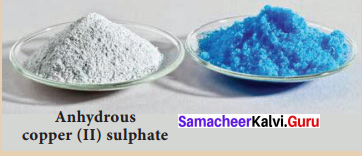
Answer:
- The reaction between anhydrous copper (II) sulphate and water is used as a test for water.
- The white solid turns blue in the presence of water.
Activity -3
Question 1.
Place a sample of tap water on a clean watch glass and place it over a beaker containing water, as shown in Tap water the figure. Boil the water in the beaker. When all the water has evaporated from the watch glass, remove it from the burner and let it cool. What do you see on the watch glass?
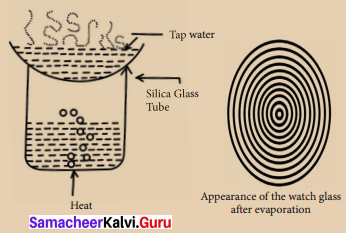
Answer:
- We can observe a number of concentric rings of solid matter deposited on the watch glass.
- These are the dissolved solids left behind after the evaporation of water Salts, minerals and impurities are the solids dissolved in water.
Activity -5
Question 1.
Take two pots with similar plants. Water one of the plants with tap water and the other with sea water. Record your findings and note the difference observed.
Answer:
Observation:
- Due to the high salinity of sea water, the plant starts to droop
- The plant which is watered with tap water grows well.
Activity – 6
Question 1.
Take samples of water from different sources (like a tube well, a lake, a pond or a river) and pour equal quantities of each sample of water into different test tubes. Measure the height of water in each test tube with a scale. Add one or two drops of liquid soap to each test tube. Shake each test tube five times and observe the height of the lather in each sample. Record your observations in the table. Which water is soft ? Which water is hard? Can you say why?
Answer:
Samples of water (Source):
- Tap water
- Well water
- Pond water
- River water
Height of lather:
- Less
- Less
- More
- More
Question 2.
Which water is soft?
Answer:
- Pond and river water are considered as soft due to presence of very small quantities of salts.
- Salts are present in very small quantities.
Question 3.
Which water is hard?
Answer:
Tap and well water are considered as hard due to presence of large quantity of minerals and salts.
